Strengthen Bones with Aquatic Exercises: A Comprehensive Guide
Aquatic exercises are a fantastic way of strengthening bones in a low-impact manner and improving general health. Water itself provides resistance to build muscles and increase bone density. This makes aquatic exercises a very great option for people of all ages, especially those with joint pains or conditions like osteoporosis.
Studies prove that high-intensity water aerobics significantly enhances both bone mineral density and functional fitness in postmenopausal women. But the best part of water workouts is that you'll get fit without the pain and injury. The water will give so much resistance that walking, jogging, and jumping are seemingly much better exercises than what you do on land.
Whether one wishes to prevent bone loss or keep one's bones stronger, aquatic exercises serve as an excellent addition to one's fitness activities. Added to this are the benefits of reducing stress and improving heart health; little wonder water workouts turn out to be an increasingly popular choice for the betterment of overall health and well-being.
Understanding Aquatic Exercises
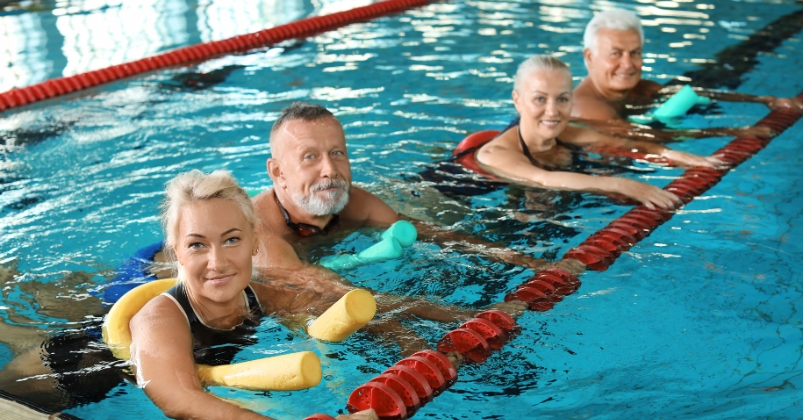
Aquatic exercises, popularly known as water exercises or water workouts, are forms of low-intensity workouts conducted in water. According to the Mayo Clinic, a water workout presents you with an extremely easy and gentle means of helping strengthen your bones, joints, and muscles without putting excessive strain on them so easily.
The water creates natural resistance that is very useful in building strength and endurance of muscles. Besides, this training can help improve one's balance, flexibility, and aerobic fitness. Due to the difference in personal fitness level and potentialities, one may modify his or her workout in the water, which can be done either in a pool, lake, or ocean.
These include water aerobics, swimming, water walking, and water jogging. Water aerobics entails carrying out aerobic exercises in water while swimming entails moving the body through the water using different strokes. Water walking and jogging are similar to those on land, only that they occur in water.
Probably most important, the benefits of aquatic workouts are that they are low-impact, meaning that they do not put too much pressure on your bones, joints, and muscles. This is the best alternative for those with conditions like arthritis, osteoporosis, and any other complication that reduces the ability to perform high-impact exercises.
According to the Mayo Clinic, aquatic exercises also reduce stress and improve muscular endurance apart from improving heart health. Aquatic exercises are fun ways of being physically active that can be done solo or as a group.
In short, water exercises provide a low-impact form of building bones while enhancing overall fitness. The inherent resistance water affords is not stressful to the joints and hence perfect for people with certain health conditions. The various forms of aquatic exercises are adaptable according to the different skill levels and abilities.
Benefits of Aquatic Exercises for Strengthening Bones
Aquatic exercises are used to strengthen bones and thereby provide good health for the bones. Some of the advantages of conducting aquatic exercises for strengthening bones include
- Low-impact activity: Aquatic exercises are low-impact and thus exert less stress on bones and joints, unlike high-impact exercises such as running. This therefore makes them an excellent option for people who suffer from conditions such as osteoporosis or are at risk of acquiring fractures.
- Buoyancy: Water's buoyancy alone helps soak some of the body's weight, minimizing its effect on bones and joints. Aquatic exercises are, therefore, ideal for individuals who suffer from bone loss or generally low bone mass.
- Resistance training: Water provides natural resistance that may help strengthen bones and muscles. This is very important, especially for people suffering from osteoporosis, since resistance training can help prevent further bone loss and even improve bone density. Aquatic exercises help in enhancing balance and coordination, hence minimizing the chances of falls and fractures.
- Stress reduction: In general, exercises are meant to reduce stress, and aquatic exercises are no exception. This contributes massively to maintaining good bone health since stress is adverse to healthy bones.
Overall, aquatic exercises are a safe and effective way to strengthen bones and improve bone health. They offer a low-impact, resistance-based workout that can be tailored to individual needs and abilities. Whether you're looking to prevent bone loss, improve bone density, or reduce the risk of fractures, aquatic exercises can be a great addition to your exercise routine.
Aquatic Exercises for Different Body Parts
Aquatic exercises can strengthen bones, muscles, and joints while being gentle on the body. Here are some aquatic exercises for different body parts:
Arms
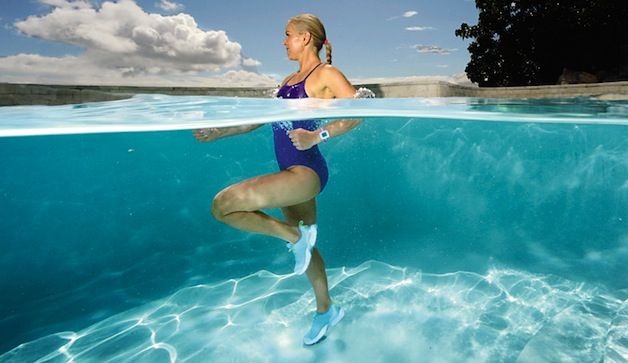
- Water walking with arm movements: Walk in the water with your arms extended at shoulder height, making circular movements with your arms.
- Arm curls: Stand in the water with your arms at your sides and elbows bent. Slowly lift your forearms towards your shoulders and lower them back down.
- Tricep pushdowns: Hold onto the edge of the pool with your elbows bent at your sides. Push down on the water to straighten your arms and then slowly release.
Core and Abdominal Muscles
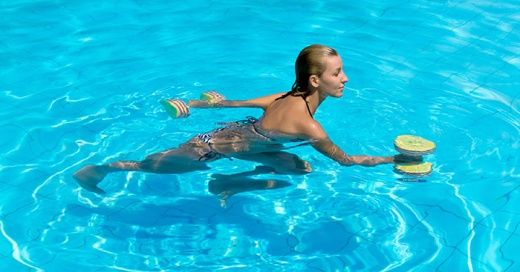
- Water crunches: Stand in the water with your arms extended in front of you. Bend your knees and bring them towards your chest while lifting your arms towards your knees.
- Flutter kicks: Hold onto the edge of the pool and extend your legs behind you. Kick your legs up and down while engaging your core muscles.
- Torso twists: Stand in the water with your feet shoulder-width apart. Twist your torso to the left and then to the right, engaging your abdominal muscles.
Hips and Spine
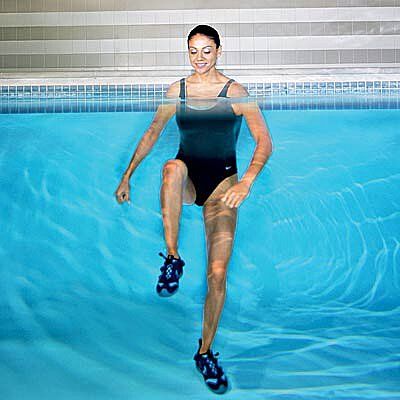
- Water walking with knee lifts: Walk in the water, lifting your knees towards your chest with each step.
- Hip extensions: Stand in the water with your hands on your hips. Lift one leg behind you, keeping it straight, and then lower it back down. Repeat on the other side.
- Spine stretch: Stand with your back against the pool wall and your arms extended at shoulder height. Slowly arch your back and then round your spine forward.
Body Weight Exercises
- Squats: Stand in the water with your feet shoulder-width apart. Slowly lower your body down into a squat position and then stand back up.
- Lunges: Stand in the water with one foot in front of the other. Slowly lower your body down into a lunge position and then stand back up. Repeat on the other side.
- Jumping jacks: Stand in the water with your feet together. Jump your feet out to the sides and raise your arms above your head. Jump your feet back together and lower your arms back down.
Aquatic exercises can be a great way to strengthen bones and muscles while being gentle on the body. Incorporate these exercises into your workout routine to improve your overall health and fitness.
Aquatic Exercises and Balance
Aquatic exercises can help improve balance and stability, which can reduce the risk of falls and injuries, especially in older adults. The buoyancy of water reduces the impact on joints and bones, making it easier to perform exercises that may be difficult on land. Additionally, water resistance provides a gentle yet effective way to strengthen muscles and improve overall fitness.
Balance exercises in water can be particularly beneficial for those with balance issues. The water provides a safe and supportive environment to practice balance exercises, reducing the risk of falls. Some examples of aquatic balance exercises include:
- Standing on one leg while holding onto the pool edge
- Walking forwards, backward, and sideways in the water
- Balancing on a pool noodle or flotation device
- Performing squats or lunges in the water
It is important to note that while aquatic exercises can be a great way to improve balance, they should not be the only form of exercise. It is recommended to also incorporate land-based exercises to maintain overall strength and balance.
In addition to balance exercises, water aerobics classes can also be a great way to improve overall fitness and reduce the risk of falls. These classes typically include a variety of exercises such as walking, jogging, and jumping in the water, which can help improve cardiovascular health, muscular strength, and endurance.
Overall, aquatic exercises can be a safe and effective way to improve balance and reduce the risk of falls, especially for older adults or those with balance issues. Incorporating a variety of aquatic exercises into a fitness routine, along with land-based exercises, can help maintain overall strength and balance.
Aquatic Exercises for Pain Management
Aquatic exercises can be an excellent way to manage pain, especially for those with joint issues or for those who find high-impact exercises painful. Water provides buoyancy, which further cushions the joints and minimizes impact; hence, this is a low-impact exercise option.
One of the studies found that aquatic exercises could help enhance pain, quality of life, and daily function in patients with musculoskeletal conditions, such as back pain. Usually, physicians recommend aquatic exercises for patients with back pains because they are generally low-impact.
Many different aquatic exercises can be done to help manage pain, including:
- Water walking: This involves walking back and forth across the pool, using the resistance of the water to strengthen muscles.
- Water jogging: Similar to water walking, but with a jogging motion to increase intensity.
- Leg lifts: Standing in waist-deep water, lift one leg at a time to strengthen the hips and legs.
- Arm curls: Using water weights or resistance bands, perform curls to strengthen the arms and shoulders.
- Flutter kicks: Lying on your back in the water, alternate lifting each leg to strengthen the core and legs.
It's important to consult with a healthcare professional before starting any exercise program, especially if you have a history of joint issues or pain. They can help you determine what exercises are safe and effective for you.
Overall, aquatic exercises can be a great way to manage pain while also strengthening bones and muscles in a low-impact way.
Different Types of Aquatic Exercises
Aquatic exercises are a low-impact way to strengthen bones and muscles. Here are some different types of aquatic exercises that can help improve bone strength:
- Water walking: Walking in water is a great way to get started with aquatic exercises. It is a low-impact exercise that can be done in shallow water. Water walking can help improve cardiovascular health, increase muscle strength, and improve balance.
- Jogging and running: Jogging and running in water is a great way to increase the intensity of your workout. This type of exercise can help improve cardiovascular health, increase muscle strength, and improve bone density.
- Swimming: Swimming is a great way to get a full-body workout. It is a low-impact exercise that can help improve cardiovascular health, increase muscle strength, and improve bone density. Swimming can also help improve flexibility and range of motion.
- Exercising with water shoes: Water shoes can help provide traction and support during aquatic exercises. They can also help protect your feet from rough surfaces on the pool floor.
- Strength training: Strength training in water can help improve muscle strength and bone density. Resistance bands can be used to add resistance to exercises such as bicep curls and leg extensions.
- Stretching and range of motion exercises: Stretching and range of motion exercises in water can help improve flexibility and range of motion. These exercises can also help improve balance and coordination.
- Cross-training: Cross-training in water can help improve overall fitness and reduce the risk of injury. Combining different types of aquatic exercises can help improve cardiovascular health, increase muscle strength, and improve bone density.
Overall, aquatic exercises can be a great way to strengthen bones and muscles. With a variety of exercises to choose from, it is easy to find a workout that fits your fitness level and goals.
Aquatic Exercises and Endurance
Aquatic exercises dramatically build endurance and strengthen the cardiovascular system. Natural resistance created by water will help you to build muscular strength and increase your muscular endurance. Water offers a low-impact environment that is soft on your bones, joints, and muscles, ideal for individuals of all ages and fitness levels.
Probably one of the most productive ways to improve your endurance regarding aquatic exercises would be to incorporate interval training into your routine. During interval training, you want to switch between high and low intensities of exercises or even periods of rest. This is going to help you with cardiovascular endurance and burn more calories than steady-state exercise.
The other effective way to enhance your endurance with aquatic exercises is by doing some resistance training. You can achieve muscular strength and endurance by using a resistance device like weights or resistance bands. You can use them with the intent of isolating a particular muscle group or with full-body workouts.
Other than resistance training, you can do some cardiovascular exercises like swimming or water aerobics that will enhance your endurance. These exercises will not only build up your cardiovascular endurance but also improve your overall fitness level.
Generally speaking, water exercises are very helpful for enhancing endurance and cardio. You will be able to develop muscular strength and endurance, enhance cardiovascular health, and get all the advantages of water exercise by incorporating interval training, resistance training, and cardiovascular exercises into your routine.
Safety Measures and Precautions in Aquatic Exercises
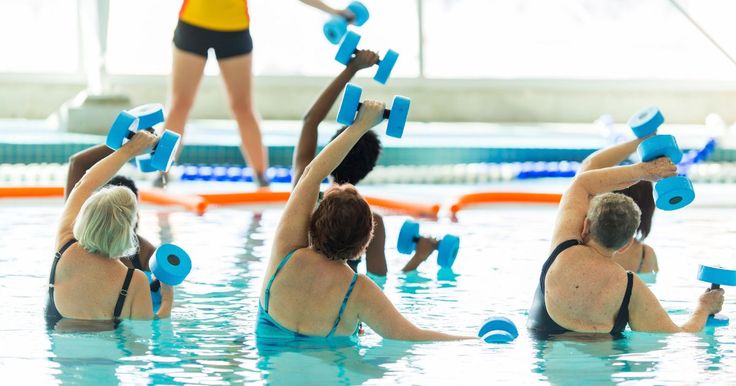
When it comes to aquatic exercises, safety should always be a top priority. Whether you are a beginner or an experienced swimmer, there are certain precautions you should take to avoid injury and make the most out of your workout. Here are some safety measures and precautions to keep in mind:
Consult with a Health Care Provider
Before starting any exercise program, it is always a good idea to consult with a healthcare provider, especially if you have any pre-existing medical conditions. Your healthcare provider can help you determine if aquatic exercises are right for you and provide guidance on how to safely perform them.
Work with a Physical Therapist or Certified Personal Trainer
If you are new to aquatic exercises or have a specific health condition, it may be beneficial to work with a physical therapist or certified personal trainer. They can help you develop a workout plan that is tailored to your individual needs and goals, as well as provide guidance on proper form and technique to avoid injury.
Be Mindful of Water Depth
The depth of the water can affect the intensity of your workout and your ability to perform certain exercises. Make sure to choose a depth that is appropriate for your skill level and the exercises you plan to perform. If you are not a strong swimmer, it is best to stick to shallower water.
Use Proper Equipment
Using the right equipment can help you get the most out of your aquatic workout while also reducing the risk of injury. Water shoes can provide traction on the bottom of the pool, while hand webs or other resistance devices can help increase resistance as your hands and arms move through the water.
Listen to Your Body
As with any exercise program, it is important to listen to your body and avoid pushing yourself too hard. If you experience pain or discomfort during an exercise, stop immediately and consult with a healthcare provider or certified personal trainer.
By following these safety measures and precautions, you can enjoy the many benefits of aquatic exercises while minimizing the risk of injury.
Aquatic Exercises for Specific Conditions
Water exercises are a good way to boost bone density and strength for people with certain health issues. Here are some examples of water exercises that help specific conditions:
Postmenopausal Women: These women have a higher chance of getting osteoporosis, which makes bones weak and easy to break. Water exercises can help make bones stronger and cut down the risk of breaks. Some helpful exercises include walking in water, doing water aerobics, and swimming.
Asthma: Water exercises can work well for people with asthma, as the warm moist air can ease asthma symptoms. Exercises like walking in water and swimming can also improve heart health, which is good for those with asthma.
Diabetes: Water exercises can help control blood sugar in people with diabetes. Water aerobics and swimming can also boost heart health, which matters a lot for those with diabetes.
Heart Disease: Water exercises can be a smart choice for people with heart disease, as they don't put much stress on the body and can improve heart health. Water aerobics and swimming can also help build muscle strength and flexibility.
It's important to consult with a healthcare professional before starting any new exercise program, especially if you have a preexisting condition. They can help determine which exercises are safe and beneficial for your specific situation.
Tools and Equipment for Aquatic Exercises
Aquatic exercise is a low-impact activity that can help improve bone health. To get started with aquatic exercises, you need some basic equipment. Here are some tools and equipment that can help you get the most out of your aquatic exercise routine:
Hand Webs
Hand webs are tools you put on your hands and arms to face more resistance as you move in the water. They can boost your strength and overall fitness. You can pick from different sizes and resistance levels of hand webs to suit your needs.
Water Shoes
Water shoes help you keep your footing on the pool bottom. They also give extra support to your feet and ankles. These shoes come in handy when you walk or run in the pool, as they lower the risk of slipping and falling.
Paddles
Paddles are another type of resistance gear you put on your hands. They're made to boost resistance when you swim, helping you get stronger and fitter overall. You can pick from different sizes and resistance levels to find the right paddles for you.
Tubing
Tubing serves as a resistance tool for various water exercises. It's rubber-made and comes in different sizes and strengths. You can use tubing to work out your upper body, lower body, or core, which makes it a handy piece of equipment for water-based fitness routines.
In summary, handwebs, water shoes, paddles, and tubing are all useful tools and equipment for aquatic exercise. By incorporating these tools into your routine, you can help improve your bone health and overall fitness level.
Finding the Right Place for Aquatic Exercises
When you're looking for a place to do water exercises, picking the right spot makes a big difference. Here are some choices to think about:
Local Pool:
A lot of community pools have water exercise classes or times when you can swim on your own to do your water workouts. This works well if you like to exercise with other people or don't have a pool at home.
Gym:
If a gym has a pool, they offer water exercise classes too. This is good if you want to use other workout equipment or prefer exercising at a gym.
Mayo Clinic Health System:
Mayo Clinic Health System provides water therapy for people who've been hurt or have health issues that make regular workouts tough. This choice works well for folks needing extra care and direction.
Cannon Falls:
Cannon Falls, a Minnesota city, has a community pool for water workouts. People living nearby might find this a cheap way to exercise in water.
Whatever spot you pick for your water exercises, check that the place has the right gear and safety steps. Also, talk to your doctor before you start any new workout plan.
Aquatic Exercises and Nutrition
In addition to aquatic exercises, proper nutrition is also important for maintaining and strengthening bones. Eating a balanced diet that includes foods rich in calcium, vitamin D, and protein can help support bone health. Here are some key nutrients to focus on:
- Calcium: Calcium is essential for building and maintaining strong bones. Good sources of calcium include dairy products, leafy green vegetables, and fortified foods such as cereal and orange juice.
- Vitamin D: Vitamin D helps the body absorb calcium and supports bone health. Sunlight is a natural source of vitamin D, but it can also be found in fatty fish, egg yolks, and fortified foods such as milk and cereal.
- Protein: Protein is important for building and repairing tissues, including bone tissue. Good sources of protein include lean meats, poultry, fish, beans, and nuts.
It's important to note that while a diet rich in these nutrients can help support bone health, excessive intake of certain nutrients, such as calcium, can have negative effects on health. It's best to aim for a balanced diet that meets your individual needs.
In addition to eating a balanced diet, staying hydrated is also important for bone health. Drinking plenty of water can help keep bones strong and healthy.
Incorporating aquatic exercises into your routine can also help support bone health.
As discussed earlier, aquatic exercises provide a low-impact workout that can help strengthen bones and improve overall health. By combining aquatic exercises with a balanced diet, you can help support your bone health and maintain strong, healthy bones.
Research and Advancements in Aquatic Exercises
Through the years, water-based workouts have become one of the best exercise methods to protect bone health. Research shows that water exercises influence bone density. These exercises boost bone density levels in older people. The Journal of Aging and Physical Activity has published studies that indicate water exercises can improve bone density in women after menopause.
Besides improving bone density, water exercise helps to lessen joint pain and build up muscles. The Journal of Rehabilitation Medicine reported on a thorough review of controlled trials that looked at how lower limb strength got better for patients with muscle and skeletal problems.
A study published in the Journal of Clinical Rheumatology found that water exercises boost physical performance and ease pain for people with osteoarthritis.
In recent years, water workouts have seen some changes. New underwater gear such as treadmills and resistance bands, has emerged to make water workouts more challenging. These changes have made water workouts easier to access and more appealing to a wider group of people.
Research has shown that water exercises offer a safe gentle option for certain health issues, like osteoporosis. The Journal of Geriatric Physical Therapy reports, “Aquatic exercises provided a safer exercise alternative compared with land exercise in individuals with low bone density.”
Studies on water workouts show they can boost bone health, cut down joint pain, and build muscle strength. As new gear comes out and more people get into these exercises, we'll see more research on this soon.
Managing Your Health with Aquatic Exercises
Water-based workouts offer a gentle way to boost your health and make your bones stronger. They're a solid choice if you want to keep moving but deal with achy joints or trouble getting around. Here are some pointers to remember when you're exercising in water:
- Take it easy at first and ramp up how hard you work out. This approach helps you steer clear of injuries and builds up your strength and stamina over time.
- Pay attention to your form and how you hold yourself during exercises. This focus helps you get the most out of your workout and stops you from putting too much stress on your joints and muscles.
- Talk to a doctor or someone who knows a lot about water exercises before you start a new routine. They can give you advice that fits your specific needs and what you want to achieve.
Besides making your bones and muscles stronger, working out in water can also boost your overall function and posture. Water's natural resistance offers a tough workout that works for many muscle groups at the same time. This can enhance your balance, coordination, and flexibility.
To sum up, exercising in water is a solid choice for people who want to manage their health and build up their bones. If you use the right form, get proper guidance, and increase how hard you work, you can reap the rewards of this gentle workout.
Privacy and Communication in Health Care
When it comes to health care, privacy, and communication are two important aspects that patients need to consider. In this section, we will discuss how aquatic exercises can help strengthen bones while also addressing privacy and communication concerns.
Protected Health Information
Protected Health Information (PHI) refers to any details about a patient's health condition, care, or payment that falls under the protection of the Health Insurance Portability and Accountability Act (HIPAA).
This covers things like medical files, lab results, and insurance data. Healthcare providers must keep PHI private and share it with people who have permission to access it.
Notice of Privacy Practices
Healthcare providers must give patients a Notice of Privacy Practices (NPP). This document explains how the provider will use and share PHI, and what rights patients have regarding their PHI. Patients need to read this document and ask questions if they don't understand something.
Email Communications
Emails offer a handy way to talk to healthcare providers. But it's crucial to keep any PHI safe. Providers might use email encryption to protect PHI. Patients should never put sensitive info in an email without first making sure it's secure.
Opt-Out and Unsubscribe Link
Patients can choose not to get marketing messages from their healthcare provider. Healthcare providers must add an unsubscribe option in any marketing emails they send out.
Website Usage Information
When patients visit a healthcare provider's website, the provider may gather information about how they use it. This data helps to enhance the website and make it easier to use. Patients should check the provider's privacy policy to learn how their usage data is collected and used.
Conclusion
In conclusion, privacy and communication are important considerations when it comes to health care. Patients should review their provider's NPP, use email communication securely, and be aware of their rights regarding marketing communications. By taking these steps, patients can ensure that their PHI is protected and their communication with their healthcare provider is secure.
FAQs
Weight-bearing exercises, such as walking, running, and strength training, can increase bone density in the spine. However, aquatic exercises can also be effective in increasing bone density in the spine.
Yes, walking is a weight-bearing exercise that can help increase bone strength. It can also improve balance and coordination, which can reduce the risk of falls and fractures.
Weight-bearing exercises and resistance training are the best exercises for osteoporosis. These types of exercises help strengthen bones and improve balance and coordination.
Swimming is a low-impact exercise that can help improve bone density. The resistance of the water can help strengthen muscles and bones without putting stress on the joints.
Yes, water aerobics can be a good exercise option for people with osteoarthritis. The buoyancy of the water can reduce stress on the joints, while the resistance of the water can help strengthen muscles and improve flexibility.
Weight-bearing exercises and resistance training are the most effective exercises for strengthening bones. These types of exercises put stress on the bones, which can help stimulate bone growth and increase bone density.








